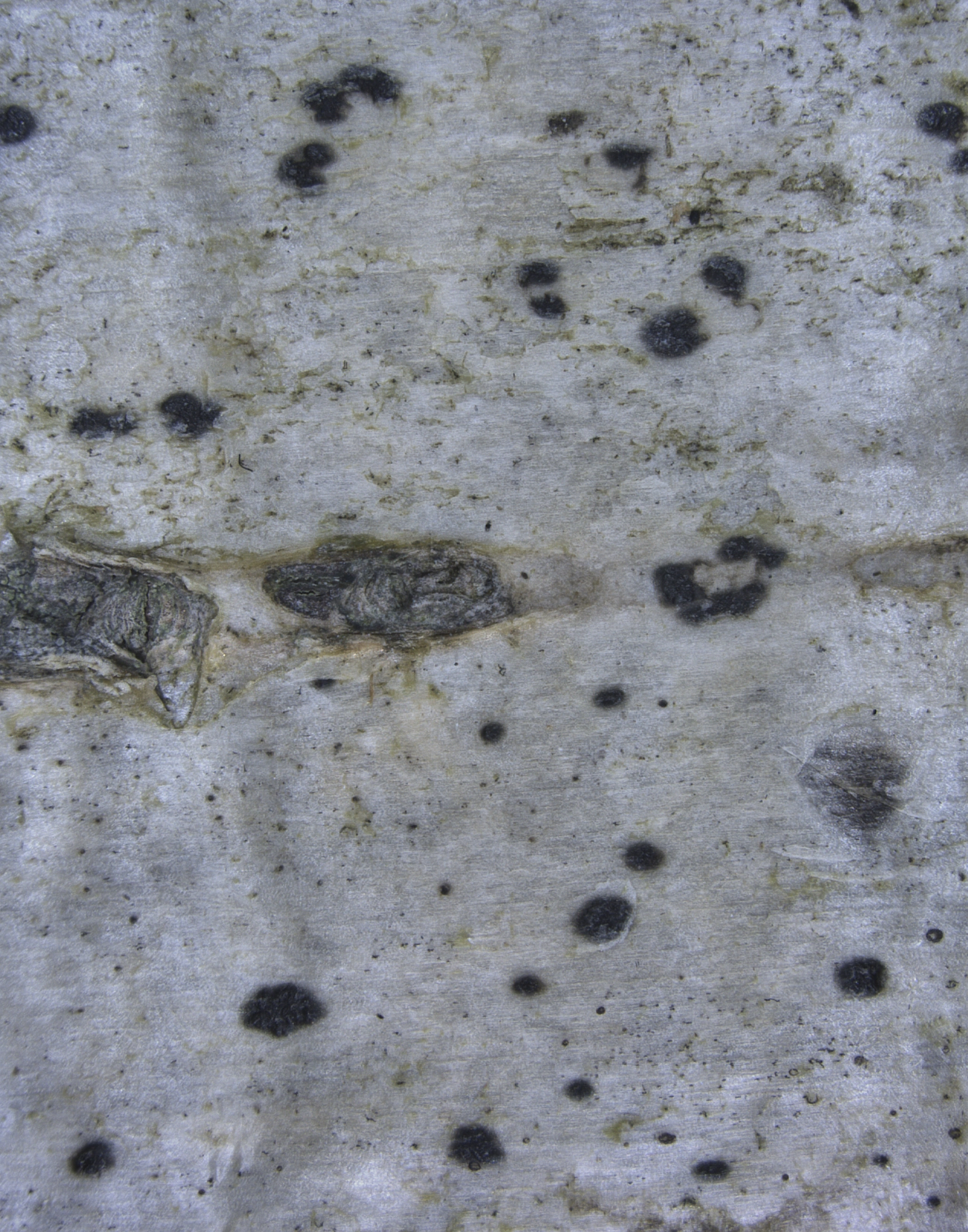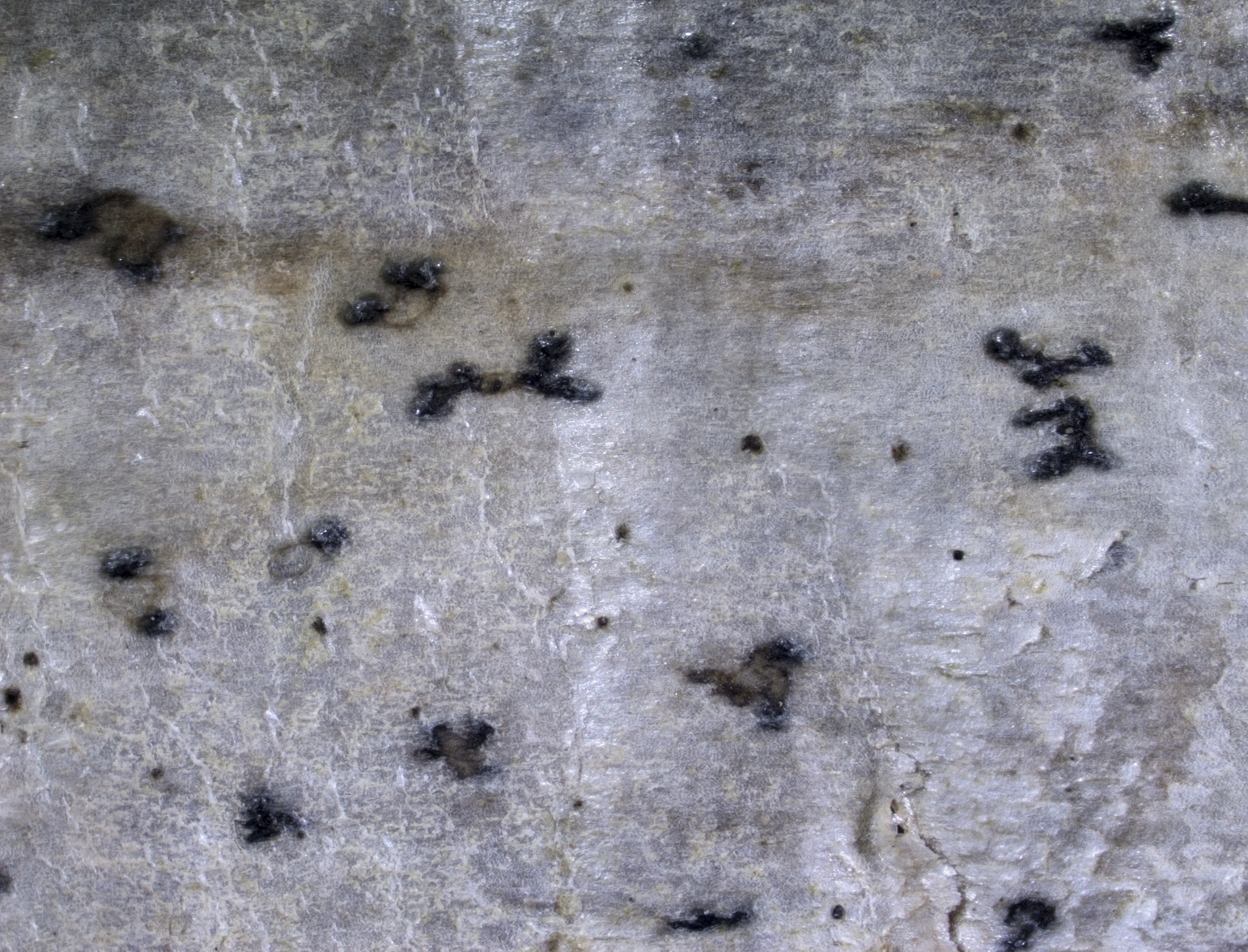Arthothelium lirellans
Arthothelium lirellans (Norway)
Arthothelium lirellans growths on smooth bark of deciduous trees in boreo-nemoral rainforests south of Bergen. It is characterized by small brownish black, maculate apothecia on a thin, pale thallus lacking photobionts. The colorless spores are divided by (4–)5–8 transverse and 0–1 longitudinal septa. The apical cell is not enlarged.
- Innhold
- Description
- Ecology
- Distribution in Norway and the Nordic countries
- Global distribution
- Similar species
Arthothelium lirellans (Norway)
Description
Thallus
The thin and indistinct thallus discolors the host bark off-white to pale grey-brown, yellowish or fawn. The margin is not determinate or more often bordered by a distinct brown line. Photobionts are lacking.
Fruitbodies
The apothecia are either level with the thallus surface or indistinctly raised. Their shape is rounded, angular or shortly elongate, and occasionally bluntly lobed or star-shaped. The apothecia are brownish black in color and do not have pruina. They are 0.3–1.2 × 0.1–0.7 mm in size and 80–120 μm tall. The disc is flat to slightly convex.
The epithecium is 10–20 μm tall, brown to olive-brown, with granules and often with bark cells.
The hymenium is colorless and 60–90 μm tall.
The hypothecium is unpigmented and up to 35 μm tall.
The paraphysoids are 1–2 μm wide. Their tips are slightly widened to 2–3 µm.
The asci are broadly obovate, with stipe, 20–50 × 22–35 µm in size, and 8-spored.
The spores are colorless, obovoid, 17–30 × 8–12 μm in size, and are divided by (4–)5–8 transverse septa and 0–1 longitudinal septa. An enlarged and undivided apical cell is not developed.
Anamorph
Pycnidia are sparse, brownish black, either immersed in the thallus or slightly raised, and 50–100 µm in size. The wall is olive-brown. The rod-shaped conidia are 3.5–6 × 0.5–1 μm in size.
Chemistry
The thallus does not react with C, K, KC, Pd or UV (C–, K–, KC–, Pd–, UV–). Lichen secondary compounds have not been detected by TLC.
The hymenium reacts I+ and KI+ deep blue. A KI+ blue ring structure has been observed in the asci.
The brown pigment in the epithecium and the wall of the pycnidia changes to greenish in K solution.
Arthothelium lirellans (Norway)
Ecology
Arthothelium lirellans is confined in Norway to the boreo-nemoral forests in Rogaland and Vestland south of Bergen. It often occurs in rather open, pine dominated forests with a high proportion of deciduous trees including common hazel (Corylus avellana), holly (Ilex aquifolium), and oak (Quercus spp.), and rowan (Sorbus aucuparia). Arthothelium lirellans often grows on thin branches with sparse lichen cover and may be a weak pioneer species.
It is a (sub-)oceanic, warm-temperate species that is further reported from old woodlands in the British Islands, laurel forests on Madeira, and from common hazel (Corylus avellana) in Austria and Slovakia.
Distribution in Norway and the Nordic countries
Arthothelium lirellans is distributed in Norway throughout the core area of the boreo-nemoral rainforests south of Bergen. In the Nordic countries, the species has also been reported from an oak forest at the west coast of Jutland, Denmark.
Global distribution
Outside the Nordic Countries, Arthothelium lirellans is known from the British Islands (W Britain, Ireland, Scotland), Madeira, Austria and Slovakia.
Arthothelium lirellans (Norway)
Similar species
Arthothelium lirellans may be confused with Arthothelium orbilliferum by external appearance, and the two species grow in similar habitats. A. lirellans can be distinguished from A. orbilliferum by the persistently I+ blue ascomatal gels, (broadly) obovoid instead of subglobose asci, and the slightly bigger, often curved spores with fewer longitudinal septa and a distinct epispore.
Naevia punctiformis is a superficially similar pioneer species on smooth bark of deciduous trees. This species is common and widespread throughout Norway. It can be easily distinguished from A. lirellans by the 3–5(–7)-transversely septate spores.
Literature
Cannon P, Ertz D, Frisch A, Aptroot A, Chambers S, Coppins BJ, Sanderson N, Simkin J and Wolseley P (2020). Arthoniales: Arthoniaceae. Revisions of British and Irish Lichens 1: 1–48.
Christensen SN, Alstrup V and Svane S (1995). Floristic notes from SW Denmark. Graphis Scripta 7(2): 87–89.
Coppins BJ and James PW (1979). New or interesting British lichens III. Lichenologist 11: 27–45.
Czarnota P, Guttová A, Halda J, Kukwa M, Liška J, Palice Z, Peksa O, Svoboda D and Vondrák J (2006). Lichens recorded during 13th Spring Meeting of the Bryological and Lichenological Section CBS on an excursion to the Tematínske vrchy hills (Považský Inovec. Mts., Slovakia). Bryonora 38: 26–39.
Frisch A, Klepsland J, Palice Z, Bendiksby M, Tønsberg T and Holien H (2020). New and noteworthy lichens and lichenicolous fungi from Norway. Graphis Scripta 32(1): 1–47.
Ihlen PG and Coppins BJ (1999). Two species of Arthothelium (Arthoniaceae, Arthoniales) new to Scandinavia. Nova Hedwigia 69(3–4): 391–397.
Sundin R (1999). Phylogenetic and taxonomic studies within Arthonia Ach. (Ascomycetes, Arthoniales). Doctoral dissertation, Department of Bot., Stockholm University.





